Escape into a world of enchantment and discovery as you embark on a three-week vacation in Germany. This captivating country has it all – from historic cities to breathtaking landscapes, cultural treasures to culinary delights.
As you explore the charming streets of Berlin, immerse yourself in a vibrant blend of art, history, and modernity. In Munich, dive into the heart of Bavaria, where the spirit of Oktoberfest lingers year-round and architectural wonders captivate at every turn.
And when you venture into the enchanting depths of the Black Forest, be prepared to lose yourself in a fairytale-like realm of dense forests, cascading waterfalls, and picturesque villages. From savouring traditional delicacies to embracing local customs, you’ll genuinely immerse yourself in the spirit of Germany.
This 3 weeks in Germany itinerary will give you an idea of where to go, how many days to spend in each city, where to stay, and what to do during your trip.
THINGS TO KNOW BEFORE GOING TO GERMANY
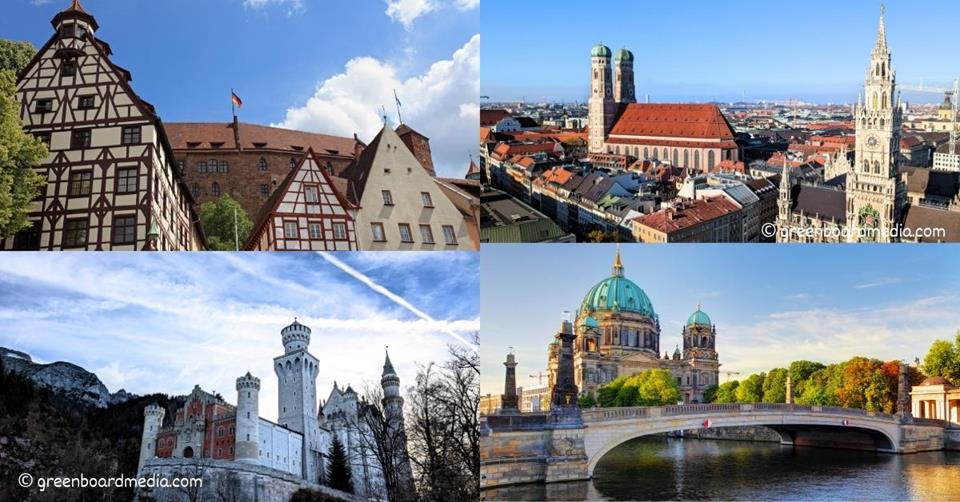
If you have 3 weeks in Europe, where would you want to go? Germany is not the usual answer, but maybe those people are missing out on something.
Before heading to Germany, there are a few essential things to know. Below is a quick list of what you need to know and remember, including transportation, currency, budget, what to pack, visa and more.
When is the best time to go to Germany
The best time to visit Germany for a vacation largely depends on personal preferences and the experiences you seek. From June to August, summer offers pleasant weather for outdoor activities and festivals nationwide.
Spring (April to June) and autumn (September to October) boast milder temperatures, fewer crowds, and vibrant foliage. If you’re a fan of Christmas markets and festive charm, consider planning your trip from late November to December during the magical Advent season.
Keep in mind that weather conditions and regional variations should be considered when choosing the best time to visit specific areas of Germany. I’ve been to Germany a few times and went in different seasons. I enjoy the autumn and spring seasons when it’s neither cold nor hot.
Although summer is a great way to enjoy the warm weather, you’ll notice that the locals are also spending time outside and in a much better mood. But remember, the summer and Christmas seasons are the busiest time in Germany, and tourism prices are much higher.
RELATED POST: Best destinations for a 3-week Spring trip
Are 3 weeks enough for Germany
Three weeks can provide an excellent vacation experience in Germany, allowing ample time to explore its diverse cities, picturesque landscapes, and immerse oneself in its rich culture. With this duration, you can visit iconic destinations like Berlin, Munich, and the Black Forest, as well as discover hidden gems and indulge in local experiences.
However, the specific itinerary and areas of interest should be considered to maximise your time. It’s best to play to see between 3-4 cities during your 20 days in Germany. Choosing the mode of transport will also affect how easy or challenging it would be to get from point A to B.
What to pack
A must-pack item for a 3-week trip to Germany is a reliable and comfortable pair of walking shoes. With so much to explore, from historic city centres to scenic trails, having comfortable footwear is essential.
In general, walking plays a big part in exploring a European city. Although there is reliable public transport, if you’re on a budget, it’s best to rely on your feet when exploring each city since trying to learn the metro can be time-consuming, and you really don’t want to get off the wrong station.
Opt for shoes that provide good support and cushioning to ensure you can comfortably navigate cobblestone streets, museums, and natural landscapes. Don’t let sore feet limit your adventures – pack those walking shoes and embark on a memorable journey through Germany.
Make sure to check our what to pack for a 3-week trip. But we also have a specific packing list for the spring, summer, and winter holidays.
How to get around
Thanks to its well-developed transportation network, getting around Germany is convenient and efficient. For affordable travel, consider utilizing the extensive train system operated by Deutsche Bahn (DB). With various ticket options, including regional passes, you can explore multiple cities at a reasonable cost.
Buses, particularly long-distance coaches like FlixBus, offer affordable alternatives, albeit with longer travel times. On the other hand, buses get to places where trains and planes are not an option.
If speed is a priority, domestic flights are the fastest option, connecting major cities with shorter travel durations. However, flights tend to be more expensive compared to trains or buses.
You can also rent a car at the beginning of your trip and drive throughout your time here. If Berlin is the start of your itinerary, you can arrange a car rental at the airport. Companies such as Avis, Europcar, Budgetcar, and other popular brands are available here.
Around €40-€70 per day is a reasonable budget depending on the size, style, and other additional features you wish to have. If you go with the most affordable choice and basic feature, around €800 for a 20-day car rental, and €1,400 for a higher-end option.
Ultimately, the best mode of transportation depends on your budget, time constraints, and personal preferences, so plan accordingly to make the most of your German adventures.
Language and currency
For visitors to Germany, the official language spoken is German. While many Germans can communicate in English, especially in tourist areas, learning a few basic German phrases to navigate daily interactions is helpful.
The currency used is the Euro (€), and cash is widely accepted throughout the country. Credit and debit cards are also widely used, but carrying cash for smaller establishments and having flexibility in rural areas is advisable.
ATMs are easily accessible, and major credit cards are accepted in most places. It’s worth noting that some businesses may not accept foreign cards, so having some cash on hand is always handy.
Average travel cost for 3 weeks in Germany
For backpackers on a budget, it’s possible to keep costs low by staying in hostels or budget accommodations, cooking your meals or opting for inexpensive local eateries, and using public transportation. A rough estimate for a backpacker budget would be around €40-60 per day, totalling approximately €840-1260 for three weeks.
For mid-range travellers who seek a balance between comfort and cost, staying in mid-range hotels or guesthouses, enjoying a mix of affordable local dining and occasional restaurant meals, and using a combination of public transportation and occasional taxis, the average daily cost would range from €80-120. This would amount to around €1680-2520 for three weeks.
Luxury travellers can expect a higher budget for their trip. Staying in upscale hotels or luxury accommodations, dining at fine restaurants, and utilizing private transportation or chauffeur services will naturally increase expenses. A luxury trip in Germany could easily cost €200 or more per day, resulting in a total budget of approximately €4200 or more for three weeks.
Visa and COVID-19 protocol
Visa for Germany is relatively straightforward. Since it’s an EU member, the government has the same visa policy as the Schengen States. This means that visitors enjoying the visa-free program can stay and travel in Germany for up to 90 days.
If you need to apply for a visa (Schengen tourist visa), the amount of days you can stay in Germany depends on how many days the embassy grants.
Travellers carrying a passport from most countries in the Americas, including New Zealand, Australia, Japan, Malaysia, Singapore, South Korea, and UAE, can enter and travel around Germany or Schengen Area for up to 90 days in a 180-day calendar.
EU nationals have a freedom of movement in Germany. If you’re applying for a Schengen tourist visa, you can submit your application no earlier than six months before your trip.
As of December 2022, Germans are still wearing masks in public transportation and spaces.
Other travel tips
PINNED MAP OF MUST-SEE PLACES IN GERMANY
Click the enlarge button on the top right corner. Credit: map data: Google
3 WEEKS IN GERMANY ITINERARY
Whether you’re a history buff, a nature lover, or a culture enthusiast, Germany has something to offer everyone. So, get ready to embark on a journey of a lifetime, where each day unfolds a new chapter in your German adventure.
But if you want to see more places in Europe but not too far from Germany, check out our 3 weeks in Central Europe itinerary. We also have 3 weeks in Western Europe itinerary.
Berlin for 4 days
Start your trip on a captivating four-day vacation in Berlin, Germany’s vibrant capital city. Begin your exploration with a visit to iconic landmarks such as the historic Brandenburg Gate and the stunning Reichstag building. Immerse yourself in history at the Berlin Wall Memorial and Checkpoint Charlie, and gain insight into the city’s past.
Delve into Berlin’s rich art scene by exploring renowned museums adorned with captivating murals like the Pergamon Museum and the East Side Gallery. Indulge in the city’s culinary offerings at bustling food markets and traditional beer gardens.
This is a great place to start your 20 days in Germany because many flights land in this capital city. Plus, from here, you won’t have a hard time getting to other parts of the country, whether by train, plane, bus, or driving.
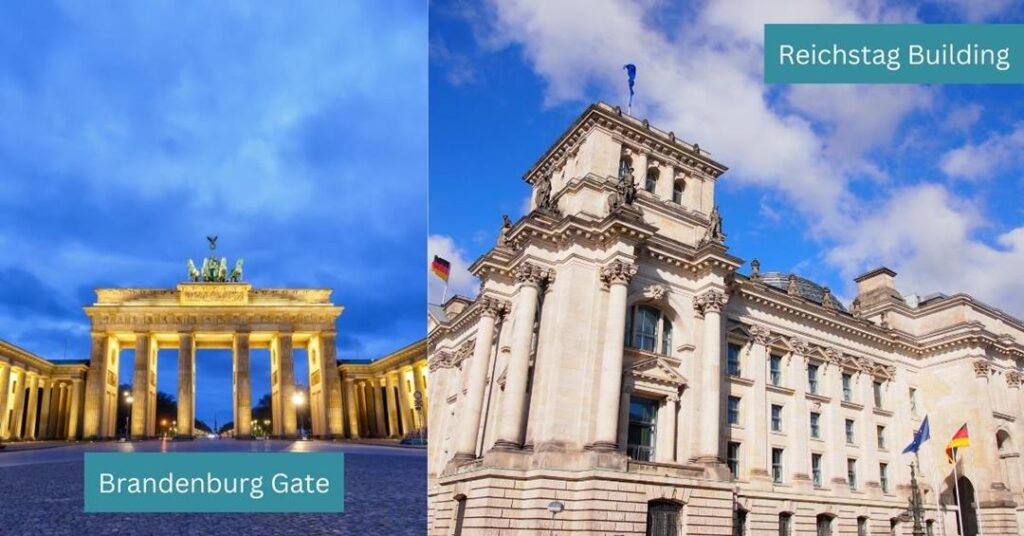
Things to do in Berlin
- Brandenburg Gate
- Discover Berlin – join a walking tour or a specific Third Reich WWII tour or a street art tour or get a hop-on, hop-off bus pass
- Reichstag Building
- Berlin Wall Memorial and East Side Gallery – check this tour
- Museum Island
- Holocaust Memorial
- Sachsenhausen Concentration Camp – book an affordable tour
- Checkpoint Charlie
- Berlin Television Tower (Fernsehturm) – get your skip-the-link ticket
- Charlottenburg Palace
- Explore the nightlife and culinary via a food tour and/or pub crawl
Accommodations in Berlin
- Affordable: a&o Berlin Hauptbahnhof or Ballhaus Berlin Hostel or New Hostel Berlin Mitte
- Mid-range: Living Hotel Großer Kurfürst or NH Collection Berline Mitte
- Luxury: Steigenberger Hotel Am Kanzleramt or Berlin Marriott Hotel
Nuremberg for 3 days
Soak up the city’s captivating history by exploring the medieval wonders of the Old Town. Admire the awe-inspiring Nuremberg Castle and soak in panoramic views of the city. Discover the poignant chapters of World War II at the Documentation Center Nazi Party Rally Grounds.
Try out the iconic Nuremberg sausages and indulge in traditional Franconian cuisine at cosy taverns. Wander through the charming streets, taking in the Gothic architecture and visiting notable landmarks like the Frauenkirche.
Enjoy the vibrant cultural scene by visiting renowned museums such as the Germanisches Nationalmuseum. Enjoy an evening of entertainment at lively music venues and beer gardens.
On your final day, visit the picturesque Nuremberg countryside and explore the scenic landscapes and charming villages.
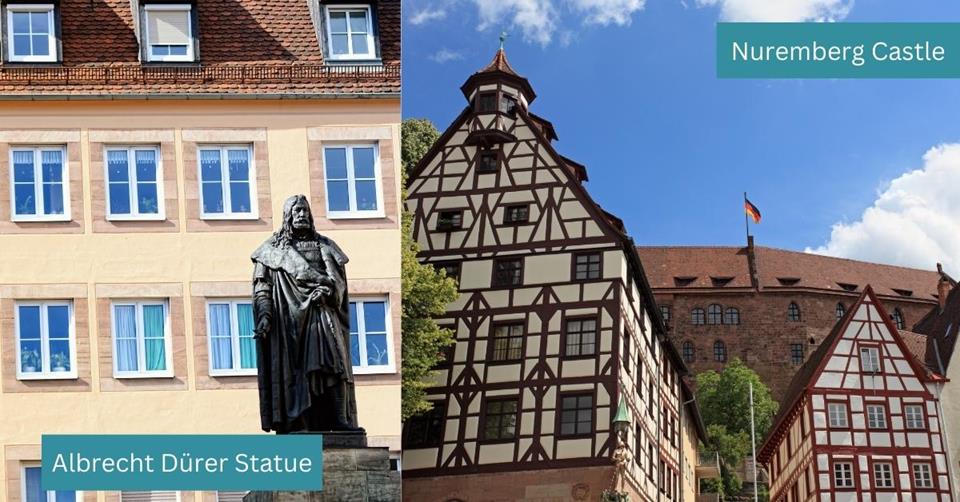
Things to do in Nuremberg
- Nuremberg Castle
- Old Town (Altstadt) – join a 1.5-hour walking tour or sign up for a sightseeing train tour or get a hop-on, hop-off bus pass
- Documentation Center Nazi Party Rally Ground
- You can also do a combo tour for Old Town and Nazi Rally Ground
- German National Railway Museum
- Nuremberg Toy Museum (Spielzeugmuseum)
- World War II in Nuremberg – Courtroom 600 and 3rd Reich Sites tour or
- St. Lorenz Church
- Albrecht Dürer House
- Nuremberg’s Medieval Dungeons – book a tour
- Nuremberg Trials Memorial (Memorium Nürnberger Prozesse)
- Christmas Market (Christkindlesmarkt) – if visiting in December, don’t miss one of the world’s oldest and most famous Christmas markets
- Go on an exciting pub crawl
Accommodations in Nuremberg
- Affordable: a&o Nurnberg Hauptbanhof
- Mid-range: B&B Hotel or Hotel-Gasthof Bub or Hotel Continental
- Luxury: Best Western Hotel or Hotel Elch or Melter Hotel & Apartments
Munich for 4 days
Munich, a vibrant city with rich history and culture, is a must-visit destination. It offers an array of world-class museums, beautiful architecture, and a unique blend of traditional and modern German life. The city’s heart, Marienplatz, boasts the stunning New Town Hall and its Glockenspiel, a major crowd-pleaser with its animated figures dancing to chimes.
The Munich Residenz, the former royal palace, offers insight into Bavarian history with its opulent interiors. Art enthusiasts shouldn’t miss the Alte Pinakothek, home to European masterpieces from the Middle Ages to the 18th century.
For relaxation, the English Garden is one of the world’s largest urban parks, perfect for a leisurely stroll or picnic. Nymphenburg Palace’s grand baroque architecture and extensive gardens are a testament to the city’s royal past.
And for a taste of Bavarian tradition, visit the Hofbräuhaus, one of the city’s oldest beer halls, for some local brew and pretzels. Making a day trip to Neuschwanstein Castle and Linderhold is also highly recommended – it’s definitely one of my favourite places during my 3 weeks in Germany.
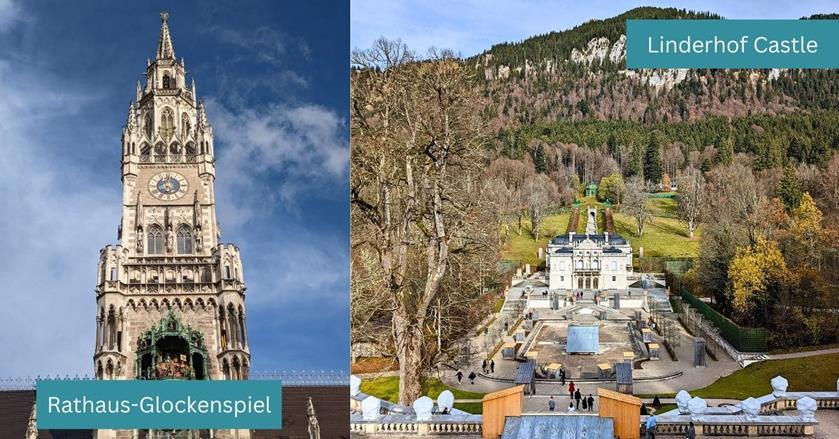
Things to do in Munich
- Marienplatz (Old Town)
- Nymphenburg Palace
- Explore Munich – sign up for the Third Reich WWII tour or join a ghost and spirit tour
- English Garden
- Munich Residenz
- Neues Rathaus
- Deutsches Museum
- Viktualienmarkt – join a food tour around the market or a Bavarian dinner and drinks
- BMW Museum
- Hofbräuhaus München
- Neuschwanstein Castle and Linderhof Palace – book a full-day tour – take a day trip to this fairy-tale castle nestled in the Bavarian Alps, a masterpiece of the Romanticism Era
- The Olympic Park
- Cuvillies Theater
- TimeRide VR Time Travel – read the reviews
- Salzburg day trip tour from Munich
- Dachau Concentration Camp Memorial Site – get there by train
- Allianz Arena
- Day trip to Rothenburg and Nordlinger Ries – beautiful medieval towns and houses, book a tour
- Day trip to Salzburg – birthplace of Mozart, join a tour and take the train
Accommodations in Munich
- Affordable: 1st Creatif Hotel Elephant or The 4YOU Hostel
- Mid-range: Hotel Jedermann or Hotel Demas City
- Luxury: Hotel Torbrau or Eden Hotel Wolff or Hotel Mirabell
Stuttgart for 4 days
With 3 weeks in Germany, you could visit a less-popular city like Stuttgart. It is nestled in the heart of Germany’s Baden-Württemberg region and is a city where rich history intersects with vibrant modernity. It’s renowned as a hub of the German automotive industry, housing headquarters and museums of world-famous brands like Mercedes-Benz and Porsche.
Stuttgart’s architecture is a fascinating mix: Medieval castles and palaces contrast with contemporary buildings like the Stadtbibliothek (City Library) and the Staatsgalerie, an ultra-modern art museum. Don’t miss the Schlossplatz, the city’s largest square, surrounded by historical buildings and lush green parks.
Culinary enthusiasts will enjoy Swabian specialities, such as Maultaschen and Spätzle. Finally, Stuttgart is part of the largest wine-growing region in Germany, so wine tasting is highly recommended.

Things to do in Stuttgart
- Mercedes-Benz Museum
- Porsche Museum
- Schlossplatz
- Wilhelma Zoo and Botanical Garden
- Staatsgalerie Stuttgart
- Stuttgart Television Tower (Fernsehturm
- Killesberg Park
- Old Castle (Altes Schloss)
- New Castle (Neues Schloss)
- Wine Tour
Accommodations in Stuttgart
- Affordable: a&o Stuttgart or Jugendherberge International
- Mid-range: Hotel Wartburg or Mirage City Hotel
- Luxury: Hampton by Hilton or Arcotel Camino or Le Meridien
Frankfurt or Dusseldorf for 5 days
I personally visited both. Since I rented a car in Frankfurt, it made it easy for me to travel to Dusseldorf as well. Cologne, Essen, and Dortmund are just around the corner as well, making my day trip quite fruitful.
But if you want to choose one city only, between Frankfurt and Dusseldorf, it depends on your interests. If you decide on Dusseldorf but can see that you can squeeze in Frankfurt, this one-day in Frankfurt guide will definitely come in handy.
Frankfurt, Germany’s financial hub, boasts a futuristic skyline and historic sites like the Romerberg area and St. Bartholomew’s Cathedral. The Palmengarten offers a botanical oasis, while the Stadel Museum hosts an impressive art collection.
Conversely, Dusseldorf is known for its fashion industry and art scene and offers a vibrant old town, ‘Altstadt’, hosting over 300 bars and restaurants. Stroll along the Rhine embankment promenade for riverside views, or visit the modern Media Harbour.
Art lovers will enjoy the Kunstsammlung Nordrhein-Westfalen and K20. If you go to Dusseldorf, this means that you can also visit Cologne, Essen, and Dortmund since these places are very near one another.
Both cities offer unique experiences, Frankfurt blending old and new and Dusseldorf thriving in fashion and arts, making either an excellent choice.

Things to do in Frankfurt
- Römer (Old Town)
- Frankfurt River – book a cruise
- St. Bartholomew’s Cathedral
- Palmengarten
- Städel Museum
- Discover nightlife via a fun pub crawl
- Main Tower
- Museum Embankment (Museumsufer)
- Kleinmarkthalle – try local food and produce at this indoor market in the city centre
- The River Main
- Scavenger Hunt – which is a fun self-guided city tour
- Museumsufer
- Goethe House and Museum
- Eiserner Steg
- Old Sachsenhausen
- Schirn Kunsthalle
- Half-day trip to Heidelberg – check the tour price
- Escheimer Turm
- Day trip to Rhine Valley – including a cruise
- Klassikstadt
- Day trip to Baden-Baden, Black Forest, and Strasbourg – check the schedule and price
- There’s a 7-day tour around Central Europe that leaves in Frankfurt – check the price and itinerary
Things to do in Dusseldorf
- Königsallee (King’s Avenue)
- Rhine Tower and Rhine River Cruise – book a boat tour
- Altstadt (Old Town)
- North Rhine-Westphalia Art Collection (Kunstsammlung Nordrhein-Westfalen)
- Media Harbour (MedienHafen)
- Benrath Palace (Schloss Benrath): Explore this Baroque-style mansion and its beautiful gardens.
- Carlsplatz Market – savor local flavours at this vibrant market, offering fresh produce, local delicacies, and more.
- Day trip to Essen, Cologne, and Dortmund
Accommodations in Frankfurt
- Affordable: Hotel Scala or Hotel Miramar am Romer
- Mid-range: Motel One or Ruby Louise Hotel
- Luxury: Sofitel Opera or Hilton Hotel
Accommodations in Dusseldorf
- Affordable: a&o Dusseldorf or B&B Hotel
- Mid-range: Leonardo Hotel or Holiday Inn Express
- Luxury: The Niu Tab or Clayton Hotel or Carahotel
MUST-TRY GERMAN DISHES AND DRINKS
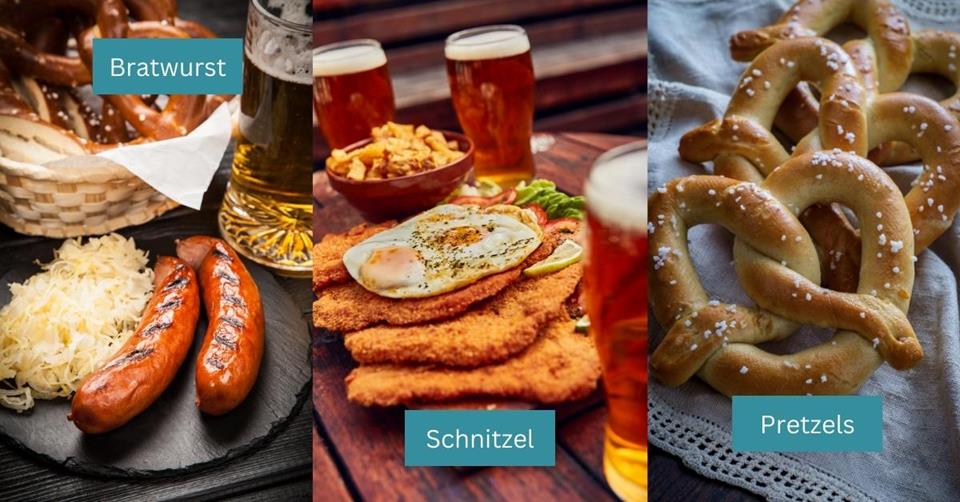
Don’t forget to visit a beer hall or two. It’s where you’ll find the best traditional German food and drinks. During your visit to Germany, make sure to indulge in these must-try German dishes to savour the country’s culinary delights:
- Bratwurst – traditional German sausages
- Sauerkraut – fermented cabbage
- Pretzels – iconic soft baked bread products with a twisted knot shape
- Schnitzel – breaded and fried meat cutlets, typically pork or veal
- Sauerbraten – classic pot roast made from marinated and braised beef
- Kartoffelpuffer – crispy potato pancakes
- Black Forest Cake (Schwarzwälder Kirschtorte) – decadent dessert featuring layers of chocolate sponge cake
- Maultaschen – Swabian-style pasta pockets
- Currywurst – popular street food dish consisting of sliced bratwurst topped with a tangy curry ketchup sauce
- Apfelstrudel – delectable apple strudel with a flaky pastry
- Beer/bier
- Glühwein -warm and spiced mulled wine
- Schanpps – various flavours to try
- Apfelschorle – refreshing combination of apple juice and sparkling water
- Apple Strudel (Apfelstrudel) – classic dessert consisting of thinly rolled dough filled with spiced apples, raisins, and nuts
- Stollen – traditional Christmas cake made with a yeasted dough
SUMMARY OF 3 WEEKS IN GERMANY ITINERARY
From the vibrant streets of Berlin to the enchanting beauty of the Black Forest and the cultural charm of Munich, this well-crafted 3 weeks in Germany itinerary allows you to immerse yourself in the country’s rich history, indulge in delectable cuisine, and soak up the diverse landscapes.
Whether you’re exploring historic landmarks, savouring traditional dishes, or simply wandering through picturesque towns, Germany offers a treasure trove of delights to discover. I hope that this itinerary helped you plan your own that suits your needs and style.
SAVE THIS TRAVEL ITINERARY ON YOUR PINTEREST:

